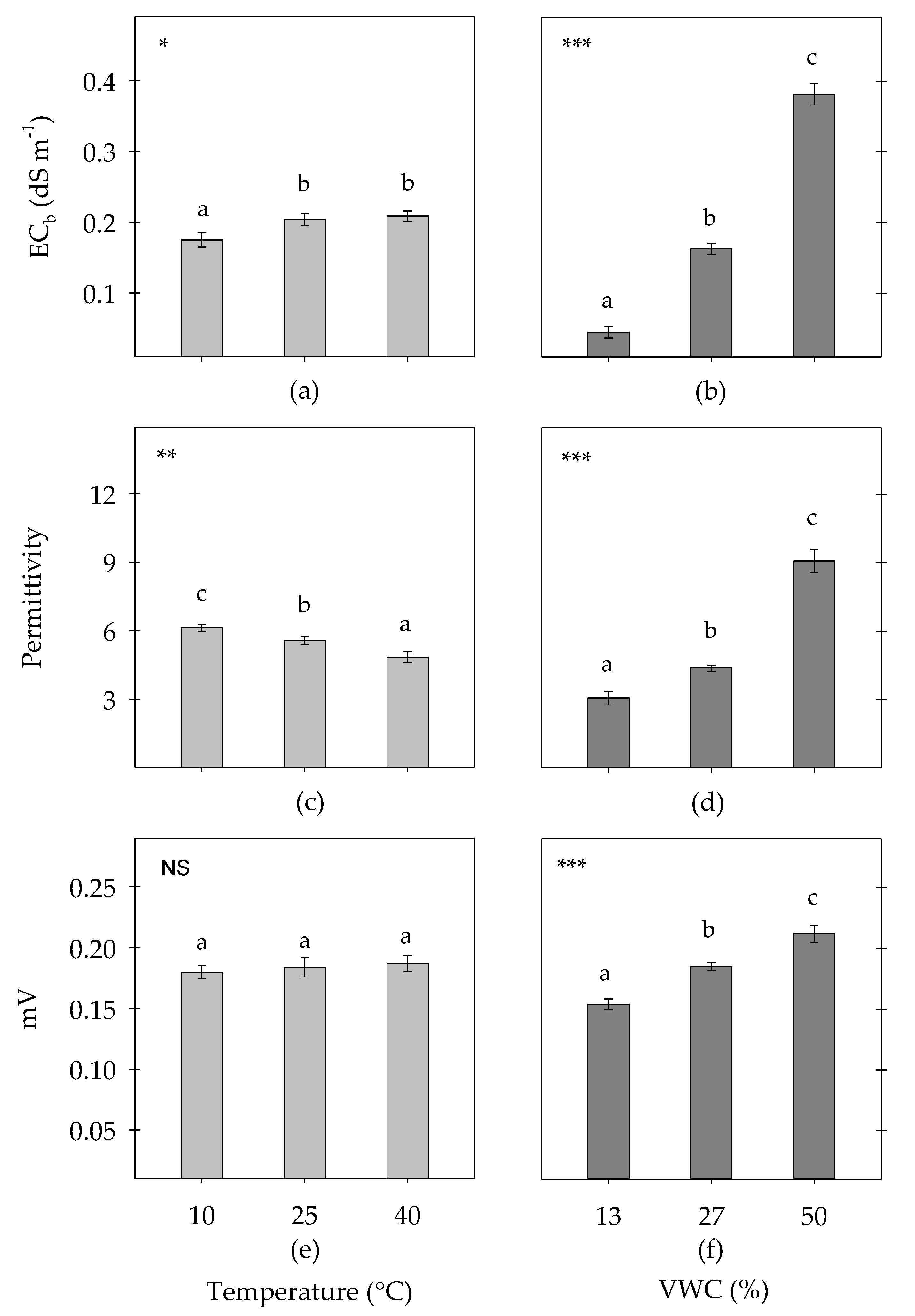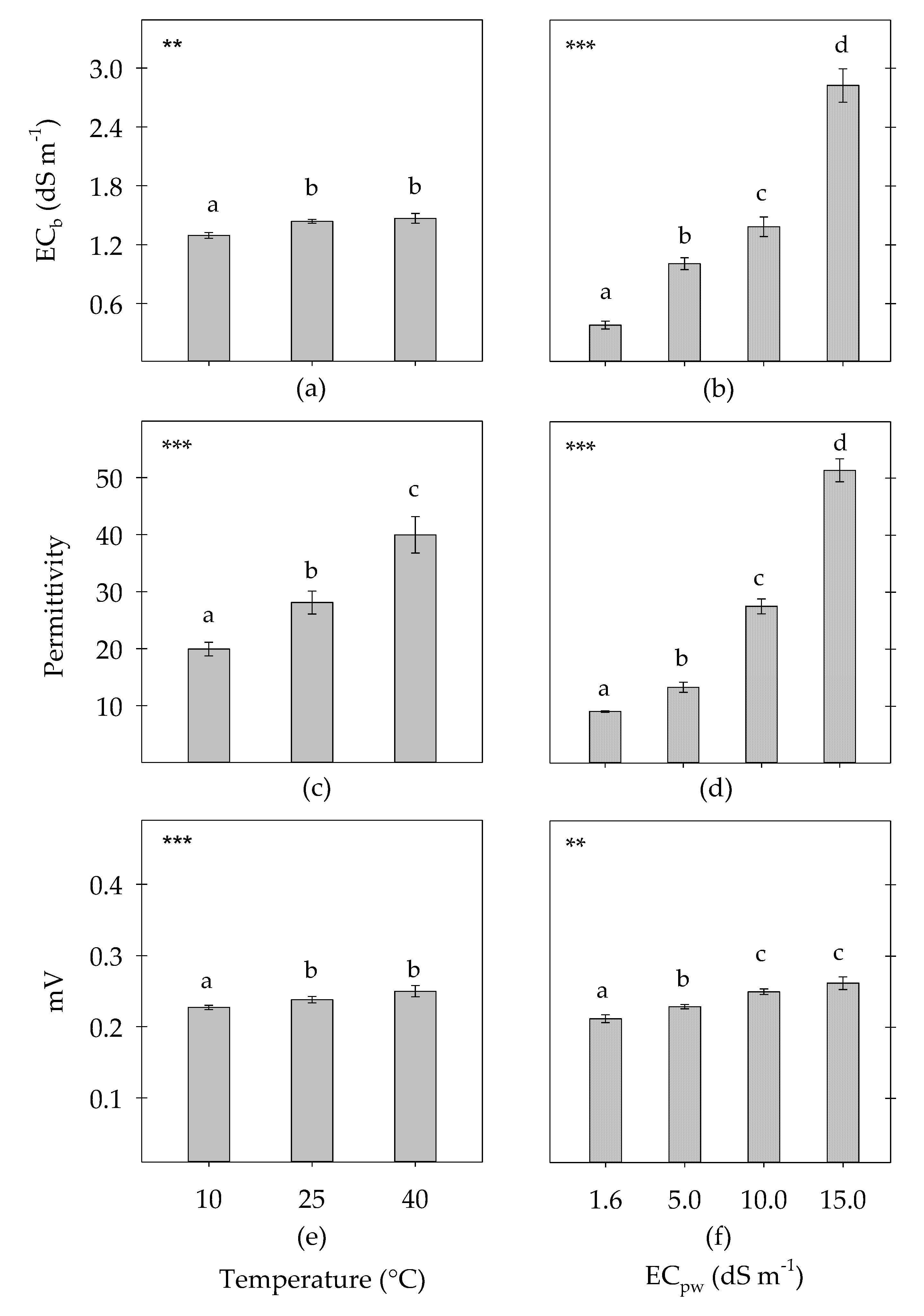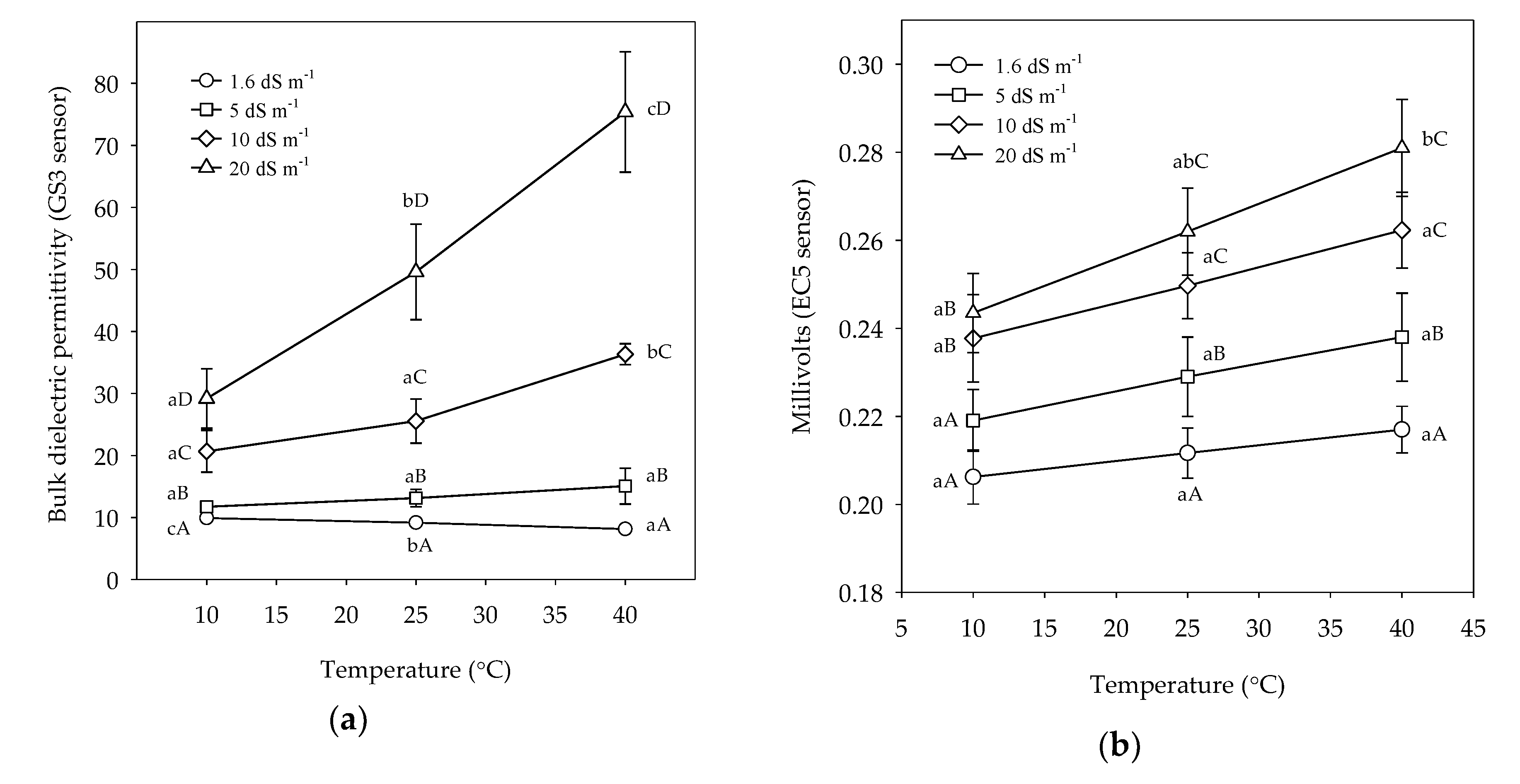Assessment of the Combined Effect of Temperature and Salinity on the Outputs of Soil Dielectric Sensors in Coconut Fiber
Abstract
1. Introduction
2. Materials and Methods
2.1. Soil Moisture Sensors
2.2. Experimental Management and Design
2.3. Sensor Calibration
2.4. Statistical Analysis
3. Results and Discussion
3.1. Effects of Substrate Temperature and VWC
3.1.1. Bulk EC
3.1.2. Permittivity and Voltage
3.2. Effects of Substrate Temperature and Salinity
3.2.1. Bulk EC
3.2.2. Permittivity and Voltage
3.3. Correction of the Effect of Temperature on Permittivity
4. Conclusions
Author Contributions
Funding
Conflicts of Interest
References
- Eller, H.; Denoth, A. A capacitive soil moisture sensor. J. Hydrol. 1996, 185, 137–146. [Google Scholar] [CrossRef]
- Incrocci, L.; Marzialetti, P.; Incrocci, G.; Di Vita, A.; Balendonck, J.; Bibbiani, C.; Spagnol, S.; Pardossi, A. Sensor-based management of container nursery crops irrigated with fresh or saline water. Agric. Water Manag. 2019, 213, 49–61. [Google Scholar] [CrossRef]
- Blonquist, J.M.; Jones, S.B.; Robinson, D.A. Standardizing Characterization of Electromagnetic Water Content Sensors. Vadose Zone J. 2005, 4, 1059–1069. [Google Scholar] [CrossRef]
- Kizito, F.; Campbell, C.S.; Campbell, G.S.; Cobos, D.R.; Teare, B.L.; Carter, B.; Hopmans, J.W. Frequency, electrical conductivity and temperature analysis of a low-cost capacitance soil moisture sensor. J. Hydrol. 2008, 352, 367–378. [Google Scholar] [CrossRef]
- Jones, S.B.; Friedman, S.P. Particle shape effects on the effective permittivity of anisotropic or isotropic media consisting of aligned or randomly oriented ellipsoidal particles. Water Resour. Res. 2000, 36, 2821–2833. [Google Scholar] [CrossRef]
- Valdés, R.; Franco, J.A.; Sánchez-Blanco, M.J.; Bañón, S. Relationships among electrical conductivity measurements during saline irrigation of potted Osteospermum and their effects on plant growth. J. Hortic. Sci. Biotechnol. 2015, 90, 571–577. [Google Scholar] [CrossRef]
- Seyfried, M.; Grant, L. Temperature Effects on Soil Dielectric Properties Measured at 50 MHz. Vadose Zone J. 2007, 6, 759. [Google Scholar] [CrossRef]
- Campbell, C.S. Response of ECH2O Soil Moisture Sensor to Temperature Variation; Decagon Devices: Pullman, WA, USA, 2002; p. 5. [Google Scholar]
- Scoggins, H.L.; van Iersel, M.W. In Situ Probes for Measurement of Electrical Conductivity of Soilless Substrates: Effects of Temperature and Substrate Moisture Content. HortScience 2006, 41, 210–214. [Google Scholar] [CrossRef]
- Rosenbaum, U.; Huisman, J.A.; Vrba, J.; Vereecken, H.; Bogena, H.R. Correction of Temperature and Electrical Conductivity Effects on Dielectric Permittivity Measurements with ECH2O Sensors. Vadose Zone J. 2011, 10, 582–593. [Google Scholar] [CrossRef]
- Or, D.; Wraith, J.M. Temperature effects on soil bulk dielectric permittivity measured by time domain reflectometry: A physical model. Water Resour. Res. 1999, 35, 371–383. [Google Scholar] [CrossRef]
- Campbell, C.S.; Campbell, G.S.; Cobos, D.R.; Bissey, L.L. Calibration and Evaluation of an Improved Low-Cost Soil Moisture Sensor; Decagon Devices: Pullman, WA, USA, 2007. [Google Scholar]
- Nemali, K.S.; Montesano, F.; Dove, S.K.; van Iersel, M.W. Calibration and performance of moisture sensors in soilless substrates: ECH2O and Theta probes. Sci. Hortic. 2007, 112, 227–234. [Google Scholar] [CrossRef]
- Valdés, R.; Ochoa, J.; Franco, J.A.; Sánchez-Blanco, M.J.; Bañón, S. Saline irrigation scheduling for potted geranium based on soil electrical conductivity and moisture sensors. Agric. Water Manag. 2015, 149, 123–130. [Google Scholar] [CrossRef]
- Ashraf, A.M.; Rahman, A. Hormonal regulation of cold stress response. In Cold Tolerance in Plants: Physiological, Molecular and Genetic Perspectives; Springer: Berlin/Heidelberg, Germany, 2018. [Google Scholar]
- Ashraf, M.A.; Rahman, A. Cold stress response in Arabidopsis thaliana is mediated by GNOM ARF-GEF. Plant J. 2019, 97, 500–516. [Google Scholar] [CrossRef] [PubMed]
- Hedhly, A.; Hormaza, J.I.; Herrero, M. Global warming and sexual plant reproduction. Trends Plant Sci. 2009, 14, 30–36. [Google Scholar] [CrossRef] [PubMed]
- Yang, X.; Dong, G.; Palaniappan, K.; Mi, G.; Baskin, T.I. Temperature-compensated cell production rate and elongation zone length in the root of Arabidopsis thaliana. Plant Cell Environ. 2017, 40, 264–276. [Google Scholar] [CrossRef]
- Markham, J.W.; Bremer, D.J.; Boyer, C.R.; Schroeder, K.R. Effect of Container Color on Substrate Temperatures and Growth of Red Maple and Redbud. HortScience 2011, 46, 721–726. [Google Scholar] [CrossRef]
- Larcher, W. Temperature stress and survival ability of Mediterranean sclerophyllous plants. Plant Biosyst. 2000, 134, 279–295. [Google Scholar] [CrossRef]
- Rhoades, J.; Raats, P.A.C.; Prather, R. Effects of Liquid-phase Electrical Conductivity, Water Content, and Surface Conductivity on Bulk Soil Electrical Conductivity1. Soil Sci. Soc. Am. J. 1976, 40, 651–655. [Google Scholar] [CrossRef]
- Mualem, Y.; Friedman, S.P. Theoretical Prediction of Electrical Conductivity in Saturated and Unsaturated Soil. Water Resour. Res. 1991, 27, 2771–2777. [Google Scholar] [CrossRef]
- Bañón, S.; Ochoa, J.; Bañón, D.; Ortuño, M.F.; Sánchez-Blanco, M.J. Controlling salt flushing using a salinity index obtained by soil dielectric sensors improves the physiological status and quality of potted hydrangea plant. Sci. Hortic. 2019, 247, 335–343. [Google Scholar] [CrossRef]
- Rhoades, J.D.; Shouse, P.J.; Alves, W.J.; Manteghi, N.A.; Lesch, S.M. Determining Soil Salinity from Soil Electrical Conductivity using Different Models and Estimates. Soil Sci. Soc. Am. J. 1990, 54, 46–54. [Google Scholar] [CrossRef]
- Hilhorst, M.A. A Pore Water Conductivity Sensor. Soil Sci. Soc. Am. J. 2000, 64, 1922–1925. [Google Scholar] [CrossRef]
- Regalado, C.M.; Ritter, A.; Rodríguez-González, R.M. Performance of the Commercial WET Capacitance Sensor as Compared with Time Domain Reflectometry in Volcanic Soils. Vadose Zone J. 2007, 6, 244–254. [Google Scholar] [CrossRef]
- Muñoz-Carpena, R.; Regalado, C.M.; Ritter, A.; Alvarez-Benedí, J.; Socorro, A.R. TDR estimation of electrical conductivity and saline solute concentration in a volcanic soil. Geoderma 2005, 124, 399–413. [Google Scholar] [CrossRef]
- Seyfried, M.S.; Murdock, M.D. Measurement of Soil Water Content with a 50-MHz Soil Dielectric Sensor. Soil Sci. Soc. Am. J. 2004, 68, 394–403. [Google Scholar] [CrossRef]
- Zhang, Y.; Shen, Y. Wastewater irrigation: Past, present, and future. WIREs Water 2019, 6, e1234. [Google Scholar] [CrossRef]
- Hasen, R.C.; Christman, J.C.; Derksen, R.C. Statistical evaluation of instruments designed to measure volumetric water content of soilless container media. Appl. Eng. Agric. 2006, 22, 753–763. [Google Scholar] [CrossRef]
- Bittelli, M. Measuring Soil Water Content: A Review. HortTechnology 2011, 21, 293–300. [Google Scholar] [CrossRef]
- Gaskin, G.J.; Miller, J.D. Measurement of Soil Water Content Using a Simplified Impedance Measuring Technique. J. Agric. Eng. Res. 1996, 63, 153–159. [Google Scholar] [CrossRef]
- Cavins, T.J.; Whipker, B.E.; Fonteno, W.C. Pourthru: A method for monitoring nutrition in the greenhouse. Acta Hortic. 2008, 779, 289–298. [Google Scholar] [CrossRef]
- Corwin, D.L.; Lesch, S.M. Apparent soil electrical conductivity measurements in agriculture. Comput. Electron. Agric. 2005, 46, 11–43. [Google Scholar] [CrossRef]
- Topp, G.C.; Davis, J.L.; Annan, A.P. Electromagnetic determination of soil water content: Measurements in coaxial transmission lines. Water Resour. Res. 1980, 16, 574–582. [Google Scholar] [CrossRef]
- Ma, R.; McBratney, A.; Whelan, B.; Minasny, B.; Short, M. Comparing temperature correction models for soil electrical conductivity measurement. Precision Agric. 2011, 12, 55–66. [Google Scholar] [CrossRef]
- Amente, G.; Baker, J.M.; Reece, C.F. Estimation of Soil Solution Electrical Conductivity from Bulk Soil Electrical Conductivity in Sandy Soils. Soil Sci. Soc. Am. J. 2000, 64, 1931–1939. [Google Scholar] [CrossRef]
- Rhoades, J.D.; Manteghi, N.A.; Shouse, P.J.; Alves, W.J. Soil Electrical Conductivity and Soil Salinity: New Formulations and Calibrations. Soil Sci. Soc. Am. J. 1989, 53, 433–439. [Google Scholar] [CrossRef]
- Peter, A.; Ferrarezi, R.; Thomas, P.; Van Iersel, M. In situ measurements of the electrical conductivity (EC) of substrates: The relationship between bulk EC, pore water EC and substrate water content. HortScience 2011, 46, 198–199. [Google Scholar]
- Malicki, M.A.; Walczak, R.T. Evaluating soil salinity status from bulk electrical conductivity and permittivity: Evaluating soil salinity. Eur. J. Soil Sci. 1999, 50, 505–514. [Google Scholar] [CrossRef]
- Cobos, D.; Campbell, C. Correcting Temperature Sensitivity of ECH2O Soil Moisture Sensors; Decagon Devices: Pullman, WA, USA, 2007; p. 7. [Google Scholar]
- Valdés, R.; Miralles, J.; Franco, J.A.; Sánchez-Blanco, M.J.; Bañón, S. Using soil bulk electrical conductivity to manage saline irrigation in the production of potted poinsettia. Sci. Hortic. 2014, 170, 1–7. [Google Scholar] [CrossRef]
- Cavins, T.J.; Whipker, B.E.; Fonteno, W.C.; Harden, B.; McCall, I.; Gibson, J.L. Monitoring and Managing pH and EC Using the PourThru Extraction Method; NC State University: Raleigh, NC, USA, 2000; p. 17. [Google Scholar]
- Sonneveld, C.; Baas, R.; Nijssen, H.M.C.; de Hoog, J. Salt tolerance of flower crops grown in soilless culture. J. Plant Nutr. 1999, 22, 1033–1048. [Google Scholar] [CrossRef]
- Inoue, M.; Ould Ahmed, B.A.; Saito, T.; Irshad, M.; Uzoma, K.C. Comparison of three dielectric moisture sensors for measurement of water in saline sandy soil. Soil Use Manag. 2008, 24, 156–162. [Google Scholar] [CrossRef]
- Spelman, D.; Kinzli, K.-D.; Kunberger, T. Calibration of the 10HS Soil Moisture Sensor for Southwest Florida Agricultural Soils. J. Irrig. Drain Eng. 2013, 139, 965–971. [Google Scholar] [CrossRef]
- Roth, K.; Schulin, R.; Flühler, H.; Attinger, W. Calibration of time domain reflectometry for water content measurement using a composite dielectric approach. Water Resour. Res. 1990, 26, 2267–2273. [Google Scholar] [CrossRef]
- Chanzy, A.; Gaudu, J.-C.; Marloie, O. Correcting the Temperature Influence on Soil Capacitance Sensors Using Diurnal Temperature and Water Content Cycles. Sensors 2012, 12, 9773–9790. [Google Scholar] [CrossRef] [PubMed]
- Goodchild, M.S.; Kühn, K.D.; Nicholl, C.; Jenkins, M.D. Temperature correction of substrate moisture measurements made in coir in polytunnel-grown strawberries. Acta Hortic. 2018, 1197, 147–154. [Google Scholar] [CrossRef]
- Kargas, G.; Soulis, K.X. Performance evaluation of a recently developed soil water content, dielectric permittivity, and bulk electrical conductivity electromagnetic sensor. Agric. Water Manag. 2019, 213, 568–579. [Google Scholar] [CrossRef]




| ECpw (dS m−1) | Equations | Significance | R2 | |
|---|---|---|---|---|
| EC5 | 1.6 | VWC = −39.30 + 423 mV | *** | 0.97 |
| 5 | VWC = −36.45 + 393 mV | *** | 0.97 | |
| 10 | VWC = −19.90 + 283 mV | *** | 0.97 | |
| 20 | VWC = −14.38 + 245 mv | *** | 0.96 | |
| GS3 | 1.6 | VWC = 11.32 + 7.18εb − 0.32εb2 | *** | 0.98 |
| 5 | VWC = 14.43 + 5.56εb − 0.21εb2 | *** | 0.97 | |
| 10 | VWC = 18.58 + 2.88εb − 0.06εb2 | *** | 0.96 | |
| 20 | VWC = 20.12 + 1.01εb − 0.008εb2 | *** | 0.97 |
| ECpw (dS m−1) | Regression Equation | R2 |
|---|---|---|
| 20 | 0.99 | |
| 10 | 0.95 | |
| 5 | 0.99 | |
| 1.6 | 0.99 |
| T (°C) | ECpw (dS m−1) | εT (F/m) | εe (F/m) | Δ (%) |
|---|---|---|---|---|
| 40 | 1.6 | 8.1 | 9.2 | 0 |
| 25 | 1.6 | 9.2 | 9.2 | 0 |
| 10 | 1.6 | 9.9 | 8.9 | 3 |
| 40 | 5.0 | 15.1 | 13.1 | 0 |
| 25 | 5.0 | 13.1 | 13.1 | 0 |
| 10 | 5.0 | 11.7 | 13.7 | 5 |
| 40 | 10 | 36.3 | 28.7 | 12 |
| 25 | 10 | 25.6 | 25.6 | 0 |
| 10 | 10 | 20.7 | 28.4 | 11 |
| 40 | 20 | 75.4 | 52.1 | 5 |
| 25 | 20 | 49.6 | 49.6 | 0 |
| 10 | 20 | 29.2 | 52.5 | 6 |
© 2020 by the authors. Licensee MDPI, Basel, Switzerland. This article is an open access article distributed under the terms and conditions of the Creative Commons Attribution (CC BY) license (http://creativecommons.org/licenses/by/4.0/).
Share and Cite
Bañón, S.; Ochoa, J.; Bañón, D.; Ortuño, M.F.; Sánchez-Blanco, M.J. Assessment of the Combined Effect of Temperature and Salinity on the Outputs of Soil Dielectric Sensors in Coconut Fiber. Sustainability 2020, 12, 6577. https://doi.org/10.3390/su12166577
Bañón S, Ochoa J, Bañón D, Ortuño MF, Sánchez-Blanco MJ. Assessment of the Combined Effect of Temperature and Salinity on the Outputs of Soil Dielectric Sensors in Coconut Fiber. Sustainability. 2020; 12(16):6577. https://doi.org/10.3390/su12166577
Chicago/Turabian StyleBañón, Sebastián, Jesús Ochoa, Daniel Bañón, María Fernanda Ortuño, and María Jesús Sánchez-Blanco. 2020. "Assessment of the Combined Effect of Temperature and Salinity on the Outputs of Soil Dielectric Sensors in Coconut Fiber" Sustainability 12, no. 16: 6577. https://doi.org/10.3390/su12166577
APA StyleBañón, S., Ochoa, J., Bañón, D., Ortuño, M. F., & Sánchez-Blanco, M. J. (2020). Assessment of the Combined Effect of Temperature and Salinity on the Outputs of Soil Dielectric Sensors in Coconut Fiber. Sustainability, 12(16), 6577. https://doi.org/10.3390/su12166577





